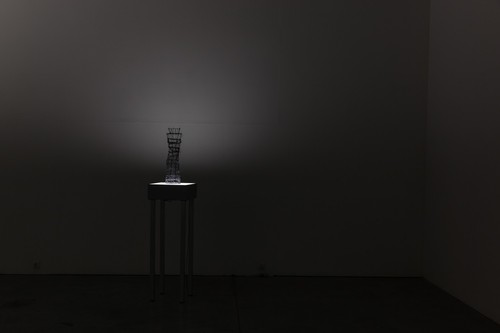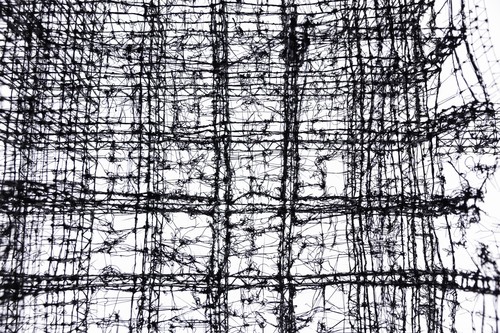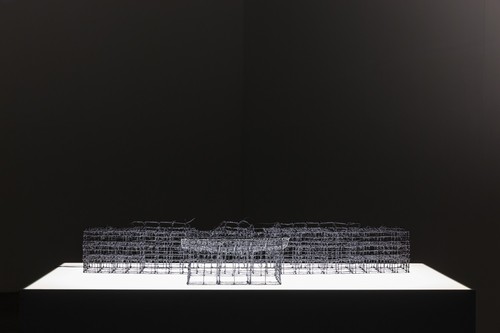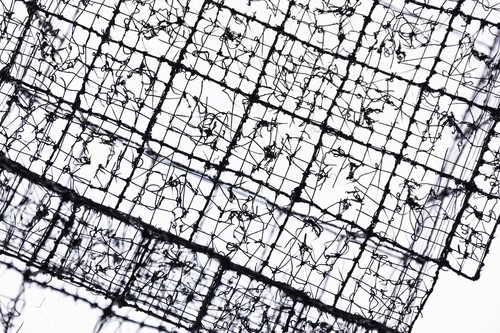

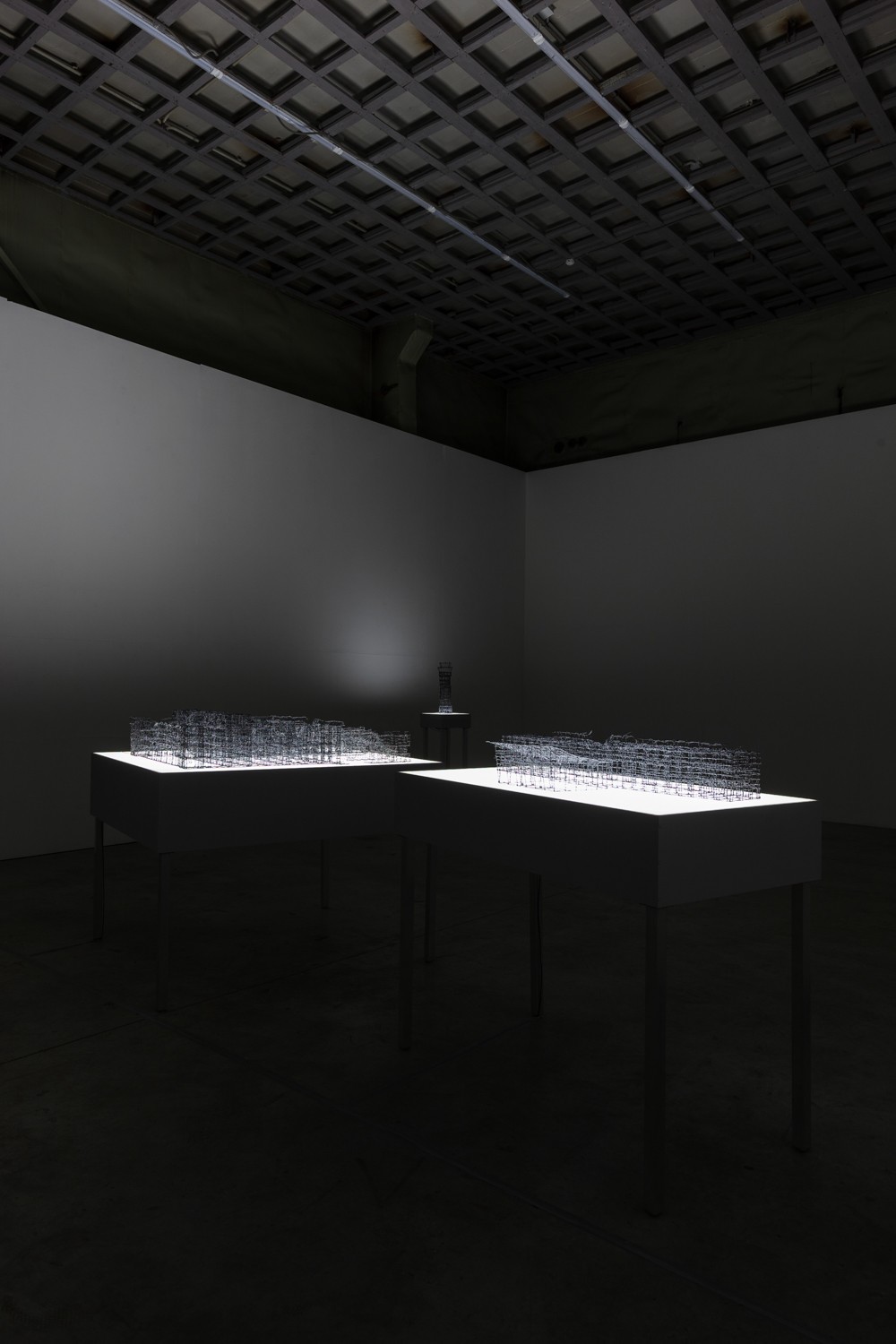










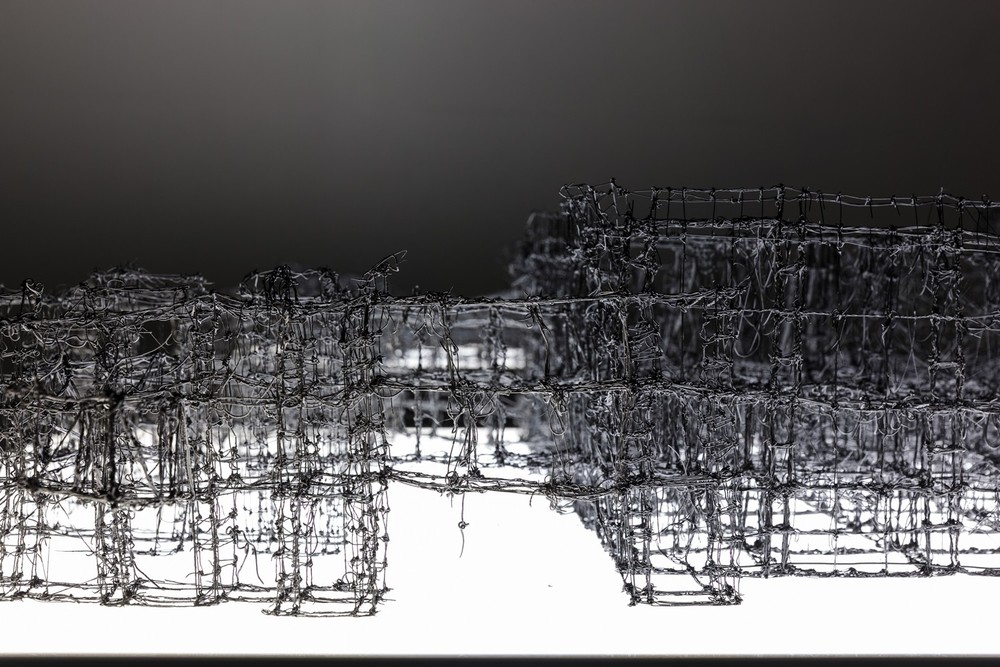







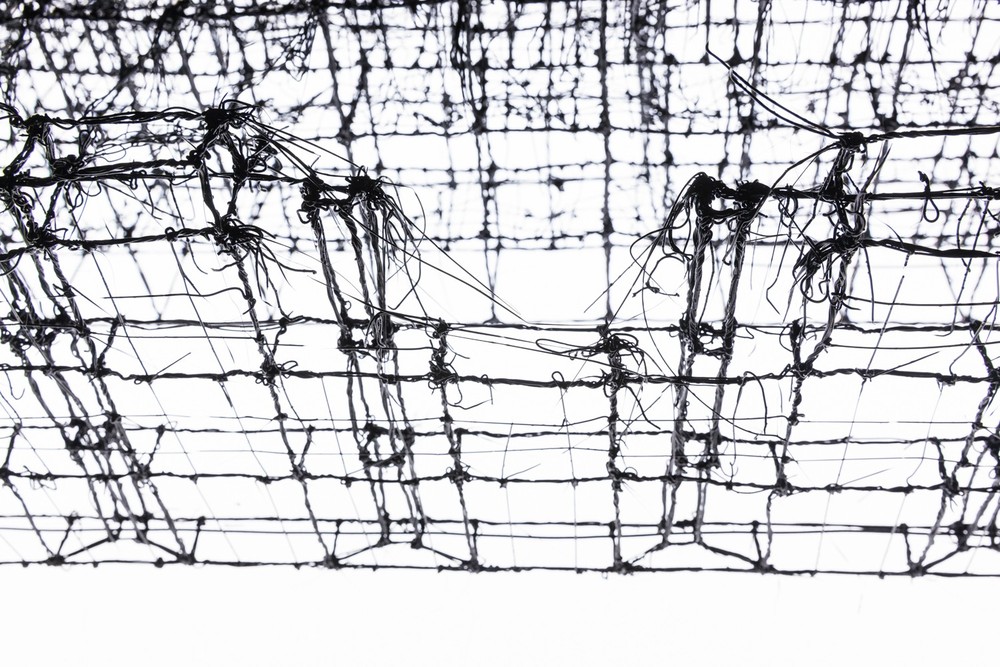



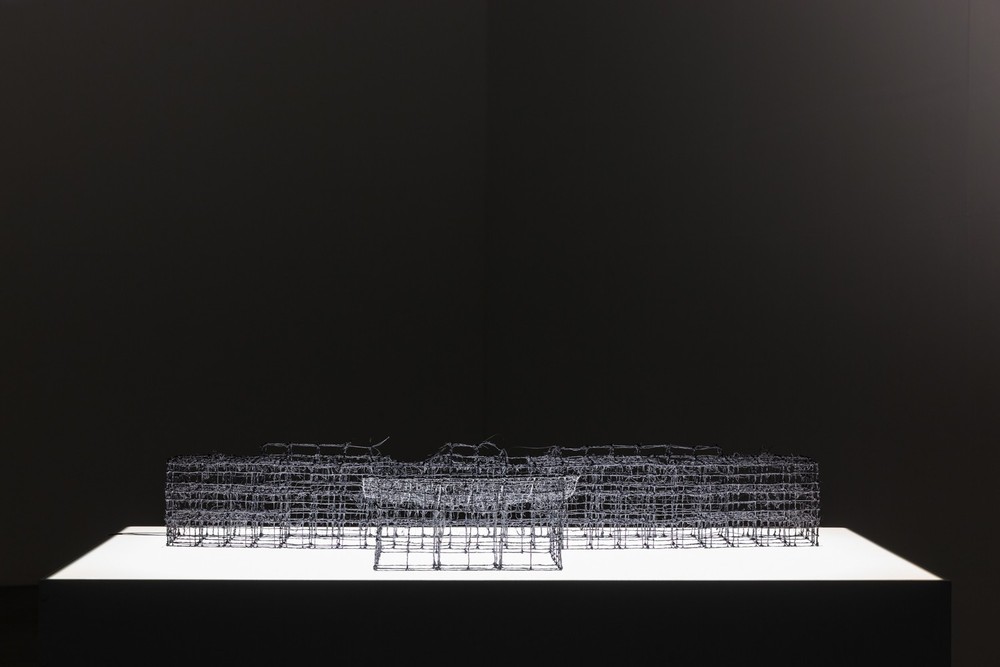





HELL NAMED AFTER SERGEI PROKOFIEV, Elektrozavod gallery, Moscow, 2017
29.06 - 06.07.2017 Photo by Vlad Shatilo Artworks: DONETSK AIRPORT CONTROL TOWER, DONETSK AIRPORT NEW TERMINAL, DONETSK AIRPORT OLD TERMINAL, NOVA In early 2015, I started experimenting with a 3d pen. This was directly related to the collapse of the ruble exchange rate and the murder of Boris Nemtsov. I could not afford to spend money working with large forms, and my general condition could be characterized as "Well, I'm fucked." There was great fatigue, but for some reason it served as fuel for work. At the same time, there was a craving for large-scale and discarnate works. I wanted them to be like a crystal thrown into a supersaturated solution: one particle instantly changes the whole structure. I wanted the technology to be important, as well as inconspicuous on the one hand and concentrated on the other. And the combination of literality of work and its name pointed out an object or phenomenon from the world and made it flutter. It became clear that the visual language of 3d pen is suitable for natural forms. Donetsk Airport named after Sergei Prokofiev drew my attention with its visuality. The new terminal was built of steel and glass. As a result of the fighting, it turned into a skeleton. The melted remains of the aircraft, crumpled pieces of plastic, stainless steel linings were spread around. The airport ceased to be an architectural object and turned into a hot monument. Art for me is a form of resistance. It seems that this is resistance to the world as it stands. Being originally excluded from nature, a man started building his own nature in the hope of finding harmony in it, but the sense of failure never left him. Modern media are filled with the images of new hell.These are the ruins of a metropolis, which is very logical and consecutive. Hell in the Scandinavian epic is cold, while in the biblical one it is hot. These antipodal "worst of places" personify the fear of the people of the past in the face of nature. Now a modern metropolis has become a force of nature, lacking its civilizing function. In 2017, this layout is more realistic than the raw material, passed through a media grinder, almost dismantled to metal pieces. The battle line is still in the airport zone. Sergei Prokofiev. In the story about the work it is always difficult to grasp the heart of the matter, event or meeting. You can describe the material, technique, pay attention to all possible references and the surrounding context. To hit the nail right on the viewer's head with the cold text, finally smashing the brains against someone else's vanity. In this case, the most valuable will remain in the distant, dusty corner of the round room. I always perceived the ruins as a part of a landscape, as a place where you can come, just like you can come to a park in the evening. Their voice got mixed up in time, one day resembling antiquity, another day - the post-apocalyptic landscape. Horror and the sublime dissolved among the columns as well as aspirin dissolving in boiled water. The only thing that appealed to them was the promise of the future, of what everyone expects. It is not for nothing the destroyed buildings leave only their skeleton, just as the person leaves it after the death. The pun in the title of the exhibition tends to be understood as a story about the after-life - an individual hell, produced by culture, politics, history, but leaving you in the privacy of your own mind. I can not remember what other work I have been observing for so long. For three years Sergei has been scrupulously "erecting" the ruins of the destroyed airport in Donetsk, periodically breaking off for commercial orders and other projects. And sometimes I could not grasp the differences between the diverse modes of his activities. Whether they might be five thousand screws that needed to be screwed in precisely to turn in the finished order in time, or kilometers of plastic for the 3d pen which he was monotonously smelting into the outline of the former airport following the images from modern periodical tabloids. Sergei has neither been to Donetsk, nor seen the destroyed airport. It is not even about the danger or impossibility of visiting these places. That was not necessary. The question is about a view, similar to those the online maps with satellite images show. Everything merges into a single landscape - whether it is a desert, the Arctic ocean, or one of the provinces of China where a 3d pen was produced. We believe that these places really exist, as well as the ongoing conflicts. The image of the airport - this place that draws space together, compresses it to one point; this place of structured routes and control of special services. For some, it gives the illusion of transparent boundaries, for others it is the promise of another life. In its field, the Internet plays such a role, generating an image of the world at the expense of someone else's experience, which becomes a personal experience, the same as a walk through abandoned places with an artist friend. Such a "hot" and vulgar theme as war always thrills people's minds. But today there is no difference between watching a new TV series or scenes from battlefields on youtube. It is not a problem of a single person, it is a logical side effect of the technological development of the witness's view representation as well the imagination machines development, that casually counts the bitcoins. Sergei often mentions that art means a form of resistance for him. It is hard to disagree with this statement. However, resistance is a state, requiring special material properties; it implicates a possibility of loss, decay, or growing entropy. The chaos of nature or war, chaos on the desk or in the head - in each of these cases a view point is necessary, which would allow chaos to take shape. Sergei found it in the heart of chaos - among the ruins of thousands of images. His exhibition seemed to me as a landscape of the subconscious mind, created by the ocean of modernity. The shed plastic skin of images passes through itself a flow, raising an inhuman scream – the agony of the destroyed order. His sun, passing through itself tens of thousands of volts, shaking convulsively and lighting up everything with the darkness of invisible static electricity. Heaven and earth changed places. Dima Filippov В начале 2015 года я начал экспериментировать с 3d ручкой. Это было напрямую связано с обвалом курса рубля и убийством Бориса Немцова. Я не мог позволить себе тратить средства для работы с большими формами, а общее состояние характеризовалось «все, пиздец». Была большая усталость, но она почему-то служила топливом для работы. Одновременно с этим возникла тяга к масштабным и нематериальным работам. Хотелось, чтобы они были подобны кристаллу, брошенному в пересыщенный раствор: одна частица моментально меняет всю структуру. Хотелось, чтобы технология была важна, но была бы незаметной с одной стороны и сконцентрированной с другой. А сочетание буквальности работы и ее названия выделяло из мира предмет или явление и заставляло его вибрировать. Стало понятно, что визуальный язык 3d ручки тяготеет к природным формам. Аэропорт Донецка имени Сергея Прокофьева привлек мое внимание своей визуальностью. Новый терминал был построен из стали и стекла. В результате боев он превратился в скелет. Вокруг лежали оплавленные останки самолетов, покореженные куски пластика, облицовки из нержавеющей стали. Аэропорт перестал быть архитектурным объектом и превратился в горячий монумент. Искусство для меня является формой сопротивления. Похоже, что это сопротивление миру как он дан. Будучи изначально исключенным из природы, человек стал строить свою в надежде найти в ней гармонию, но ощущение краха никогда не покидало его. Современные медиа наполнены образами нового ада. Это руины мегаполиса, что очень логично и преемственно. В скандинавском эпосе ад холодный, в библейском - горячий. Эти диаметрально противоположные «самые худшие из мест» олицетворяют страх тогдашних людей перед природными стихиями. Сейчас такой стихией стал современный мегаполис, лишенный своей цивилизующей функции. В 2017 этот макет более реален, чем исходный материал, пропущенный через медиа мясорубку, почти разобранный на чермет. Линия фронта до сих пор находится в зоне аэропорта. Сергей Прокофьев. В рассказе о произведении всегда трудно уловить суть вещи, события или же встречи. Можно описывать материал, технику, обратить внимание на всевозможные отсылки и окружающий контекст. Холодным текстом вбить гвоздь в голову зрителя, окончательно размазав его мозги об чужое тщеславие. При этом самое ценное так и останется лежать в дальнем пыльном углу круглой комнаты. Я всегда воспринимал руины как часть пейзажа, как место, куда можно прийти, также, как можно прийти вечером в парк. Их голос путался во времени, то напоминая античность, то постапокалиптический пейзаж. Ужас и возвышенное растворялись между колонн также, как растворялся аспирин в кипяченой воде. Единственное, что привлекало в них – это обещание будущего, того, что ожидает каждого. Не зря разрушенные здания оставляют только свой скелет, так же, как оставляет его человек после смерти. Игра слов в названии выставки тянет понять ее как рассказ о жизни «после» - индивидуальном аде, продуцируемом культурой, политикой, историей, но оставляющего тебя наедине с самим собой. Не могу вспомнить, какую еще работу я наблюдал в процессе так долго. На протяжении трех лет Сергей скрупулёзно «возводил» руины разрушенного аэропорта Донецка, периодически обрываясь на коммерческие заказы и другие проекты. Причем порой я не мог уловить различия между разными режимами его деятельности. Будь то пять тысяч шурупов, которые нужно вкрутить в точно определенных местах чтобы вовремя сдать заказ, или километры пластика для 3d ручки с помощью которого он монотонно выплавлял очертания бывшего аэропорта по снимкам из современных новостных таблоидов. Сергей никогда не был в Донецке, и никогда не видел разрушенный аэропорт вживую. И дело даже не в опасности или невозможности посещения этих мест. Это не представлялось необходимым. Здесь речь идет о взгляде, похожим на тот, который открывают онлайн карты со спутниковыми снимками. В нем все сливается в единый ландшафт - пустыня ли это, или ледовитый океан, или же одна из провинций Китая, где была произведена 3d ручка. Мы верим, что места эти реально существуют, так же, как и происходящие конфликты. Образ аэропорта - это место стягивает пространство, сжимает его в одной точке, это место упорядоченных маршрутов и контроля спецслужб. Для одних оно дает иллюзию прозрачных границ, для других является обещанием другой жизни. На своем поле такую роль играет интернет, генерируя за счет чужого опыта образ мира, который становится опытом личным, таким же, как прогулка по заброшенным местам со своим другом художником. Такая «горячая» и вульгарная тема как война всегда будоражит умы. Но сегодня нет разницы в том, чтобы смотреть новый сериал или ролики на youtube с мест боевых действий. В этом нет проблемы отдельно взятого человека- это логичный побочный эффект развития технологии репрезентации взгляда свидетеля и машинами воображения, между делом высчитывающих биткойны. Сергей часто упоминает, что искусство для него есть форма сопротивления. С этим тяжело не согласиться. Но сопротивление - это состояние, требующее особых свойств материала, с ним связаны потери, возможность распада, растущей энтропии. Хаос природы или войны, хаос на рабочем столе или в голове – в каждом из этих случаев необходима точка обзора, с которой хаос обретает форму. Сергей нашел ее в самом сердце хаоса – посреди руин тысяч изображений. Его выставка представилась мне пейзажем подсознания, созданного океаном современности. Сброшенная пластиковая кожа образов пропускает через себя ток, издавая нечеловеческий крик- агония уничтоженного порядка. Его солнце, пропускающее через себя десятки тысяч вольт дергается в конвульсиях, освещая все темнотой невидимого статического электричества. Земля и небо поменялись местами. Дима Филиппов |



